问答
发起
提问
文章
攻防
活动
Toggle navigation
首页
(current)
问答
商城
实战攻防技术
漏洞分析与复现
NEW
活动
摸鱼办
搜索
登录
注册
Apache-shiro-权限绕过漏洞汇总
shiro权限绕过漏洞,本文将这三个权限绕过的洞进行对比,他们的编号分别是 **CVE-2020-1957、CVE-2020-11989、CVE-2020-13933
0x01 简述 ------- 前段时间太忙了,忙到很多东西,只是记录了笔记,没有成文,刚好最近阶段又出来了shiro权限绕过漏洞,因此本文将这三个权限绕过的洞进行对比,他们的编号分别是 **CVE-2020-1957、CVE-2020-11989、CVE-2020-13933** 。 0x02 漏洞细节 --------- ### 1、CVE-2020-1957 #### 原理  首先在 **admin** 位置下断点,可以看到,我们网络请求,是先经过 **shiro** 处理之后,再转发到 **springboot** 进行路由分发工作。 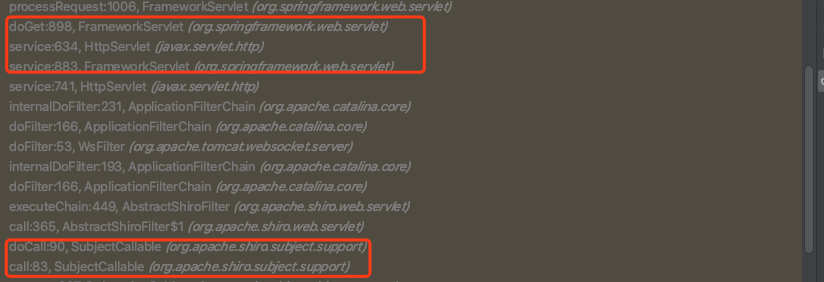 这里直接定位到 **shiro** 处理 **url** 的方法位置:**WebUtils#getPathWithinApplication** ```java public static String getPathWithinApplication(HttpServletRequest request) { String contextPath = getContextPath(request); String requestUri = getRequestUri(request); if (StringUtils.startsWithIgnoreCase(requestUri, contextPath)) { // Normal case: URI contains context path. String path = requestUri.substring(contextPath.length()); return (StringUtils.hasText(path) ? path : "/"); } else { // Special case: rather unusual. return requestUri; } } ``` 实际上继续跟进 **getRequestUri(request);** 这个方法,可以清楚的看到,实际上调用的是 **getRequestURI** 方法来获取路由中的 **URI** 请求。 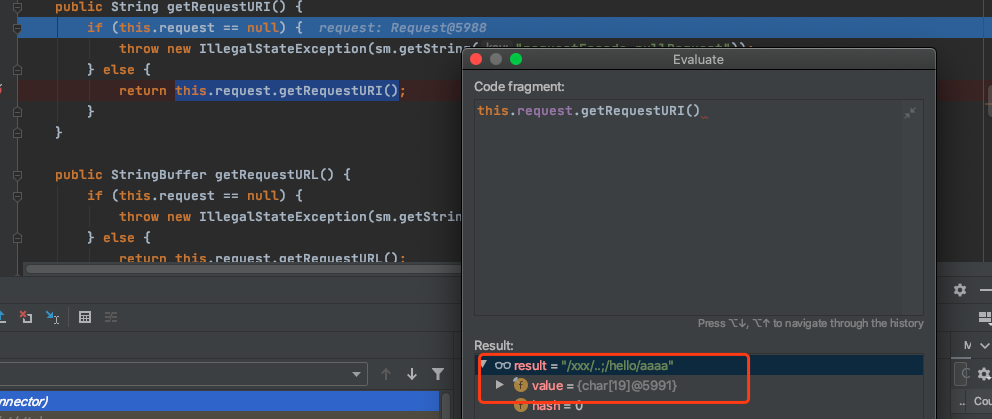 这里的 **URI** 就是我们传入的`/xxx/..;/hello/aaaa`,也就是说回到 **getRequestUri(request);** 当中,会带着这个传入的 **URI** 进入 **decodeAndCleanUriString** 进行处理。 ```java public static String getRequestUri(HttpServletRequest request) { String uri = (String) request.getAttribute(INCLUDE_REQUEST_URI_ATTRIBUTE); if (uri == null) { uri = request.getRequestURI(); } return normalize(decodeAndCleanUriString(request, uri)); } ``` 在 **decodeAndCleanUriString** 方法中会根据我们的传入的URI中`;`进行截断处理,也就是说经过处理之后,返回的结果变成了`/xxx/..` 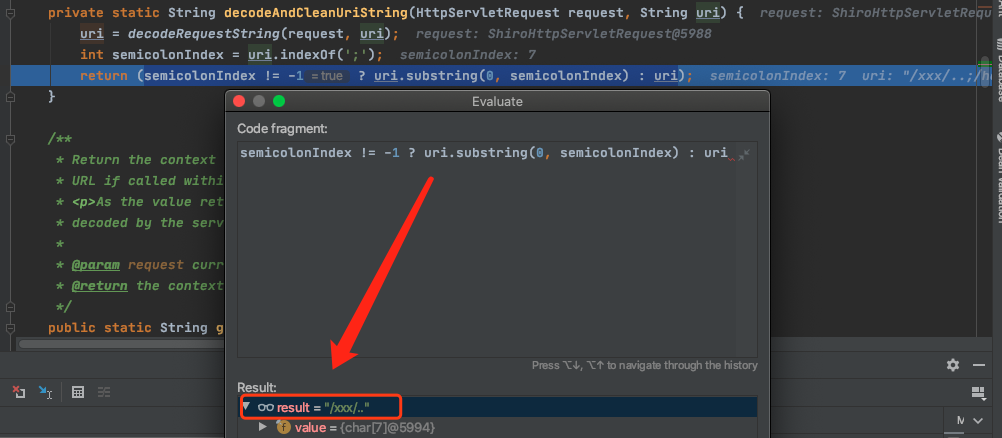 而 **normalize** 方法就会对我们传入的path进行一些处理,从注释上,也能知道这部分代码处理了什么东西: - 替换`\\`为`/` - 替换`/./`为`/` - 替换`/../`为`/` - ... ```java private static String normalize(String path, boolean replaceBackSlash) { if (path == null) return null; // Create a place for the normalized path String normalized = path; if (replaceBackSlash && normalized.indexOf('\\') >= 0) normalized = normalized.replace('\\', '/'); if (normalized.equals("/.")) return "/"; // Add a leading "/" if necessary if (!normalized.startsWith("/")) normalized = "/" + normalized; // Resolve occurrences of "//" in the normalized path while (true) { int index = normalized.indexOf("//"); if (index < 0) break; normalized = normalized.substring(0, index) + normalized.substring(index + 1); } // Resolve occurrences of "/./" in the normalized path while (true) { int index = normalized.indexOf("/./"); if (index < 0) break; normalized = normalized.substring(0, index) + normalized.substring(index + 2); } // Resolve occurrences of "/../" in the normalized path while (true) { int index = normalized.indexOf("/../"); if (index < 0) break; if (index == 0) return (null); // Trying to go outside our context int index2 = normalized.lastIndexOf('/', index - 1); normalized = normalized.substring(0, index2) + normalized.substring(index + 3); } // Return the normalized path that we have completed return (normalized); } ``` 而这里经过处理,我们的 **URI** 依然是`/xxx/..`,接着就会回到 **PathMatchingFilterChainResolver#getChain** 方法,进行权限匹配,我们的路径是`/hello/**`下需要进行权限认证,由于路径不匹配,所以权限校验自然过了。  这里在提一嘴,可以看看 **PathMatchingFilterChainResolver#getChain** 方法这一小段代码,这一段代码修复的是 [**Shiro-682**](https://issues.apache.org/jira/browse/SHIRO-682) ,具体描述可以点入链接查看。简单翻译一下就是在 **spring web** 下,通过请求 **/resource/menus** 和 **/resource/menus/** 都是能够访问到资源的,但是shiro的路径正则只会匹配到 **/resource/menus** ,忽略了 **/resource/menus/** ,所以这就绕过了。   好了,这里提一下这个地方,再回到我们刚刚上面的情况里,由于我们传入的 **URI** `/xxx/..`与权限认证的 **URI** `/hello/**`不匹配,绕过了权限验证之后,进入 **springboot** 当中进行路由分发,而在 **spring** 当中 **UrlPathHelper#getPathWithinServletMapping** 这个方法负责处理我们传入的 **URI** :`xxx/..;/hello/aaaa`,结果是返回 **servletPath** 。 ```java public String getPathWithinServletMapping(HttpServletRequest request) { String pathWithinApp = getPathWithinApplication(request); String servletPath = getServletPath(request); String sanitizedPathWithinApp = getSanitizedPath(pathWithinApp); String path; // If the app container sanitized the servletPath, check against the sanitized version if (servletPath.contains(sanitizedPathWithinApp)) { path = getRemainingPath(sanitizedPathWithinApp, servletPath, false); } else { path = getRemainingPath(pathWithinApp, servletPath, false); } ... // Otherwise, use the full servlet path. return servletPath; } } ``` 看看 **servletPath** 是怎么来的,这玩意的取值是通过`request.getServletPath();`获取到的,也就是说这里的结果是`/hello/aaaa`。这里通过 **springboot** 进行分发,自然获取到后台接口内容,整个流程: 用户发起请求`/xxx/..;/hello/aaaa`----->shiro处理之后返回`/xxx/..`通过校验的----->springboot处理`/xxx/..;/hello/aaaa`返回`/hello/aaaa`,最后访问到需要权限校验的资源。 ```java public String getServletPath(HttpServletRequest request) { String servletPath = (String) request.getAttribute(WebUtils.INCLUDE_SERVLET_PATH_ATTRIBUTE); if (servletPath == null) { servletPath = request.getServletPath(); } if (servletPath.length() > 1 && servletPath.endsWith("/") && shouldRemoveTrailingServletPathSlash(request)) { // On WebSphere, in non-compliant mode, for a "/foo/" case that would be "/foo" // on all other servlet containers: removing trailing slash, proceeding with // that remaining slash as final lookup path... servletPath = servletPath.substring(0, servletPath.length() - 1); } return servletPath; } ``` 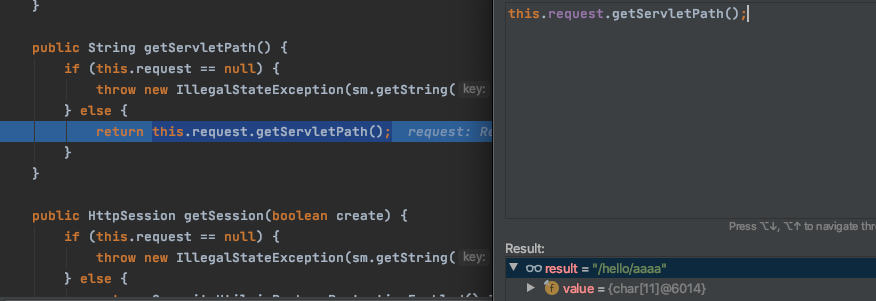 #### 修复 shiro在1.5.2当中把之前的通过 **getRequestURI** 获取URI的方式变成了 **getContextPath()** 、**getServletPath()** 、**getPathInfo()** 的组合。  这么处理之后自然变成了想要的东西。 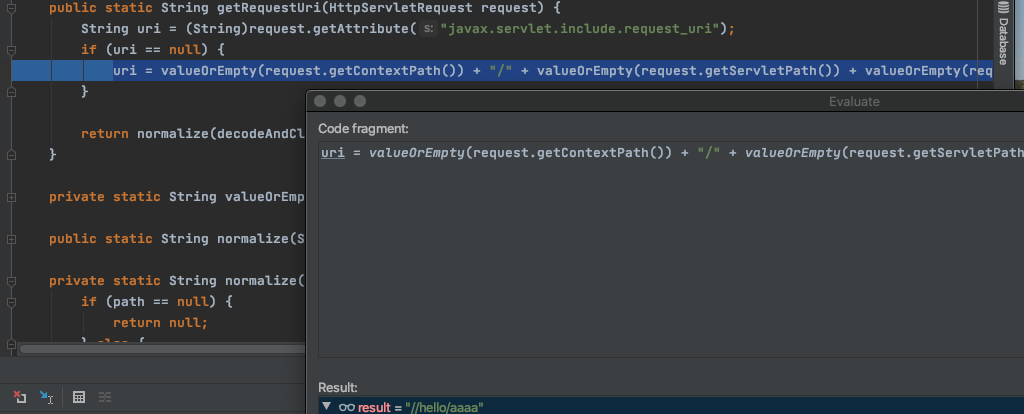 ### 2、CVE-2020-11989 #### 原理 这里的 **shiro** 拦截器需要变成`map.put("/hello/*", "authc");`,这里有两种poc,都是可以绕过 ```php /hello/a%25%32%66a /;/test/hello/aaa ``` 我们知道在shiro中的`WebUtils#getPathWithinApplication`这里会处理我们传入的url,在 **getRequestUri** 方法会调用 **decodeAndCleanUriString** 进行处理。 ```java public static String getRequestUri(HttpServletRequest request) { String uri = (String) request.getAttribute(INCLUDE_REQUEST_URI_ATTRIBUTE); if (uri == null) { uri = valueOrEmpty(request.getContextPath()) + "/" + valueOrEmpty(request.getServletPath()) + valueOrEmpty(request.getPathInfo()); } return normalize(decodeAndCleanUriString(request, uri)); } ``` 在 **decodeAndCleanUriString** 当中会调用 **decodeRequestString** 针对 **URI** 进行一次 **URL** 解码。 ```java private static String decodeAndCleanUriString(HttpServletRequest request, String uri) { uri = decodeRequestString(request, uri); int semicolonIndex = uri.indexOf(';'); return (semicolonIndex != -1 ? uri.substring(0, semicolonIndex) : uri); } public static String decodeRequestString(HttpServletRequest request, String source) { String enc = determineEncoding(request); try { return URLDecoder.decode(source, enc); } catch (UnsupportedEncodingException ex) { if (log.isWarnEnabled()) { ... } return URLDecoder.decode(source); } } ``` 所以这里的poc`/hello/a%25%32%66a`------>传入到shiro自动解码一次变成`//hello/a%2fa`------>经过 **decodeRequestString** 变成`//hello/a/a` 由于这里我们的拦截器是`map.put("/hello/*", "authc");`,这里需要了解一下shiro的URL是ant格式,路径是支持通配符表示的 ```php ?:匹配一个字符 *:匹配零个或多个字符串 **:匹配路径中的零个或多个路径 ``` `/*`只能命中`/hello/aaa`这种格式,无法命中`/hello/a/a`,所以经过 **shiro** 进行权限判断的时候自然无法命中。  而在spring当中,理解的 **servletPath** 是`/hello/a%2fa`,所以自然命中`@GetMapping("/hello/{name}")`这个mapping,又springboot转发到响应的路由当中。  另一种利用方式来自这里[《Apache Shiro权限绕过漏洞分析(CVE-2020-11989)》](https://xz.aliyun.com/t/7964),这里提到了 > 1. 应用不能部署在根目录,也就是需要context-path,server.servlet.context-path=/test,如果为根目录则context-path为空,就会被CVE-2020-1957的patch将URL格式化,值得注意的是若Shiro版本小于1.5.2的话那么该条件就不需要。  这里原因在于需要绕过 **getRequestUri** 当中的格式化uri,当 **context-path** 为空的时候,处理结果为`//hello/aaaa` ```java public static String getRequestUri(HttpServletRequest request) { String uri = (String) request.getAttribute(INCLUDE_REQUEST_URI_ATTRIBUTE); if (uri == null) { uri = valueOrEmpty(request.getContextPath()) + "/" + valueOrEmpty(request.getServletPath()) + valueOrEmpty(request.getPathInfo()); } return normalize(decodeAndCleanUriString(request, uri)); } ```  当 **context-path** 不为空的时候,处理结果为`/;/test/hello/aaaa`,然后我们知道 **decodeAndCleanUriString** 会根据`;`进行截断,截断之后的结果是`/`自然无法命中拦截器`map.put("/hello/*", "authc");`,所以自然就绕过了。   #### 修复 在1.5.3版本,采用标准的 **getServletPath** 和 **getPathInfo** 进行uri处理,同时取消了url解码。 ```php public static String getPathWithinApplication(HttpServletRequest request) { return normalize(removeSemicolon(getServletPath(request) + getPathInfo(request))); } ```  ### 3、CVE-2020-13933 #### 原理 ```php /hello/%3baaaa ``` 上面的代码进来之后,通过 **getPathWithinApplication** 处理之后变成了`/hello/;aaaa`  而 **removeSemicolon** 会根据`;`进行截断,返回的 **uri** 自然是`/hello/` ```java private static String removeSemicolon(String uri) { int semicolonIndex = uri.indexOf(';'); return (semicolonIndex != -1 ? uri.substring(0, semicolonIndex) : uri); } ``` 这个 **uri** 自然无法命中拦截器`map.put("/hello/*", "authc");`自然就过了  #### 修复 加了一个 **filter** 类 **InvalidRequestFilter** 来针对一些东西进行处理。 ```java private static final List<String> SEMICOLON = Collections.unmodifiableList(Arrays.asList(";", "%3b", "%3B")); private static final List<String> BACKSLASH = Collections.unmodifiableList(Arrays.asList("\\", "%5c", "%5C")); ```  0x03 小结 ------- 总结来看,就是利用 **shiro** 解析 **uri** 和 **spring** 解析 **uri** 之间的差异来挖这个洞。
发表于 2021-04-16 10:37:27
阅读 ( 8825 )
分类:
漏洞分析
0 推荐
收藏
0 条评论
请先
登录
后评论
l1nk3r
2 篇文章
×
发送私信
请先
登录
后发送私信
×
举报此文章
垃圾广告信息:
广告、推广、测试等内容
违规内容:
色情、暴力、血腥、敏感信息等内容
不友善内容:
人身攻击、挑衅辱骂、恶意行为
其他原因:
请补充说明
举报原因:
×
如果觉得我的文章对您有用,请随意打赏。你的支持将鼓励我继续创作!